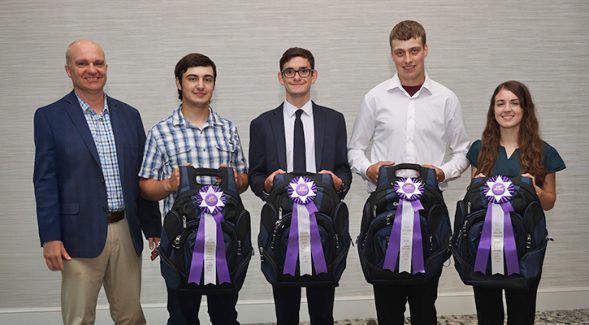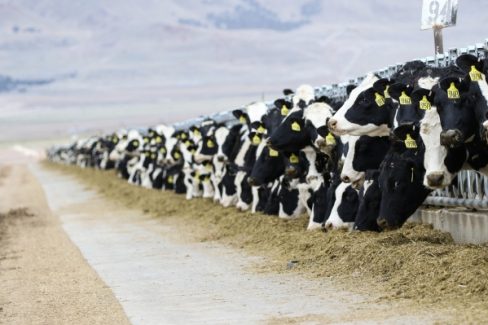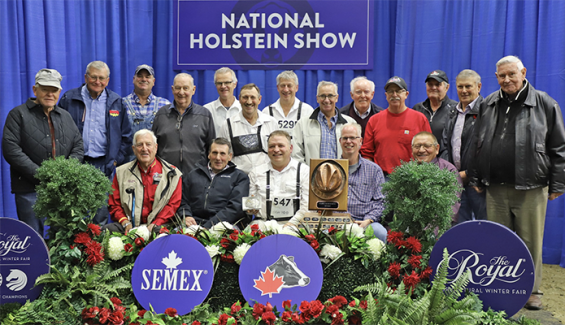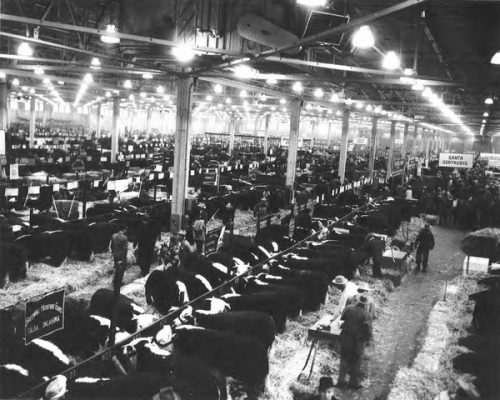
The Chicago International Livestock show was first held in 1900 and ran through 1975. Although for many years it was a beef, horse, swine and sheep show, Chicago did host some epic dairy cattle shows as well. The show was held at the International Amphitheater adjacent to the Chicago Stockyards. There were no dairy shows from 1920 to 1952, but in 1953 the dairy cattle came back to the big city in a big way. The International was held right after “Waterloo” in the 50’s but later it would change the dates to follow the Royal Winter Fair after Thanksgiving. The box cars would leave Waterloo on Sunday and arrive in Chicago Monday morning. The Toronto trip in later years would take a day longer and include two switches of the cars.
Because of the proximity to some of the finest herds in the world, the Millionaire breeding establishments surrounding Chicago and the Southern Wisconsin herds, Chicago became a “must attend show” if you were going to be a leader in the show cattle world. The weather could be a challenge as several times there would be snow on the ground and temperatures were sometimes below freezing. There would also be the culture shock of farm boys and girls having an up and close view of one of the roughest parts of the big city, the south side of Chicago.
 CHICAGO MEMORIES
CHICAGO MEMORIES
In 1953, 12 railroad cars brought Jersey cattle from Waterloo to Chicago, one car came from Ontario and trucks came from Ohio, Indiana, Wisconsin, Maryland and Kentucky, and the home state of Illinois. The Jersey show was second largest with 260 head. The Grand Champions were Farmer Brown, 1st 2 Year Old bull for Pioneer Farm, Old Lyme Connecticut, and Grand Champion Cow was Sybil Design Etta Ideal for Ideal Farm, Vestal, New York. Along with her full brother, Chiefs Son of Etta, the Reserve Champion bull made up the first produce of dam. Premier Breeder was Happy Valley Farm, Rossville, Georgia, and Premier Exhibitor was music publisher Gustave Schirmer’s Harmony Farms, Greenwich, Connecticut, who’s show circuit that year included New York State Fair, Eastern States, Waterloo, Chicago, Portland, Oregon and finished the year at the Cow Palace in San Francisco, California.
The 1960 Holstein show was one of the best shows in history with 298 head shown from throughout the U.S. and Canada. Show days were December 1st and 2nd. Romandale was Premier Breeder and Exhibitor even through their anchor, Romandale Reflection Marquis could only muster a 3rd place after being Grand Champion the week before at Waterloo. One of the greatest show bulls of all time Gray View Crisscross was 9th out of 11 in the Junior Yearling bull class.
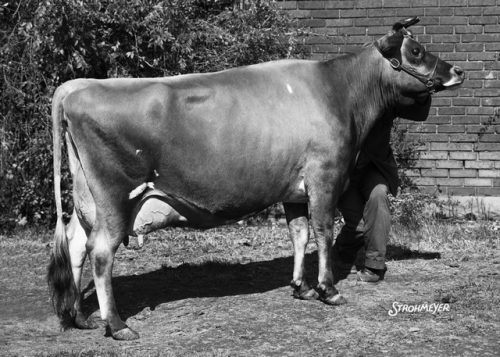
Pinn Blonde Oakland, one of the greatest show cows of all times, got her start at Chicago as a fresh 2 year old. Calving that year for the first time on the first of September, she would show in the Junior show, win her class and was named Reserve Grand Champion cow. In the open show a few days later she would end up 4th in a strong class. She caught the eye of Max Gordon who purchased her for his farm in Lynn, Indiana. A year later she was consigned to the All-American sale in Columbus where she was purchased by Heaven Hill Farm, who were starting to put together some of the greatest show cows in the land under Mr. Gordon’s guidance. Later that year (1958) she would become the first of seven Heaven Hill champions at the Royal Winter Fair in Toronto, a feat she would duplicate in 1959. “Pinn”, as she was known by, would return to Chicago in 1960 and 1962 to be named Grand Champion and Best Udder winner both years. She would also win the Aged Cow class at the All-American and was a member of several of Heaven Hills winning dairy herds throughout her eight-year show career.
Gary Lintvedt: In 1967, while attending the Chicago International, we (Crescent Beauty Holsteins) were tied next to a string of Angus from Pennsylvania. I was watching them wash, blow dry and clip from early morning till night. Being curious I asked why and how they grew the hair at home and at the show. They told me about the wetting them down morning and night and working with the hair, etc. That next year I purchased a blower and practiced at home. In 1968 Crescent Beauty had an October heifer calf (base dates then were July), Crescent Beauty Ormsby Gala, who had all the parts but just needed to be a little bit better behind the shoulders. We put her on the “Angus hair program” and she responded great. Show morning came and she was washed and then “blown up” and finished clipped. She had been 4th at both the Wisconsin State Show and State Fair, but in Chicago she was 1st and Reserve Junior Champion and ended the year being named Reserve All American, which was very important.
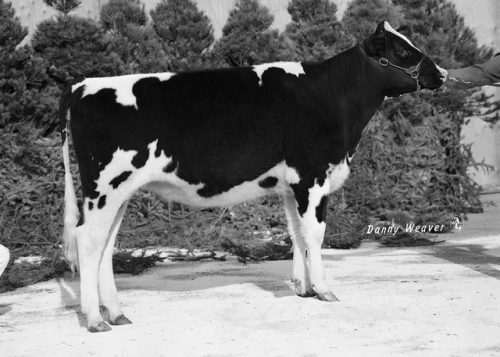
C.M. Bottema III, as a student at Purdue, was on the dairy judging team and after judging returned to the barn area and helped his dad show the famous Zendrenrust Fond Memory. C.M. remembers his dad and uncle Ray getting done showing and having a few drinks and wanting to go see Arthur Godfrey in the Amphitheater. They had no tickets but still wanted to go. When stopped at the door they told the ticket taker that their whites and show ribbons got them in. They got to see Godfrey perform.
It was cold of course in Chicago and the barns were attached to the Amphitheater. Also attached to all of this were the Stock Yard Inn and Steak House and Morris Men’s Shop, where Dad used to get his personalized Stetson hat each year. The facility was located on Halsted St. on Chicago’s South Side and attached to the famous Chicago Stock Yards all of which are no longer in existence. I cannot remember too much about the barns, but the Amphitheater is where the shows were done–it also was the site I think of the infamous 1968 Democratic Convention, so it was quite a famous venue for all sorts of activities, concerts and professional sporting events. I remember going with Dad and we would stay in a motel on Lake Shore Drive and take a taxi to the barn every day we were there. Breakfast was at a little train car style diner right across Halsted Street.
Ken Melvold participated in the 1960’s with Champ Goodwood Holsteins from Elsbery, Missouri. Along with School of the Ozarks the string totaled 9 head. Most remember the show being cold and being in the presence of show herds like Tara Hills (Heffering), Chambric, Crescent Beauty, Lakeside, Grey View and Paclamar. Always a great show and always the last show of the year.
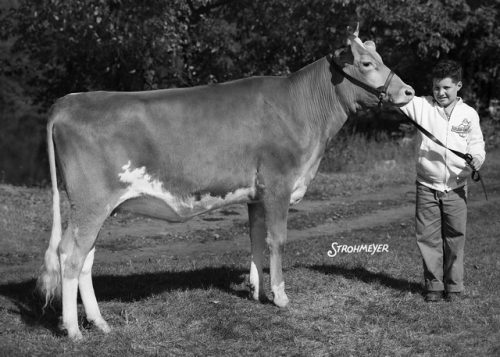
Buddy Fleming remembers making his first trip to Chicago as a nine year old 4-H member in 1957 with his Guernsey show heifer Marsh Farms P Carol. Carol had been Junior Champion at Waterloo for the future Klussendorf award winner and would repeat the honor at the International. As a youngster, Buddy recalls the “Round the World” poker games on a show box with a pot of $3,500 (1957 money) up for grabs. Later in his career Fleming made another appearance with Hanover Hill Farm after completing a three month show circuit starting in New York and traveling to Eastern States, Madison, San Francisco, and the Royal and ending the year at Chicago. The trip from the Royal to Chicago was done sitting on a wooden folding chair, as the H.S. Knill semi-truck was only equipped with one seat. Although the “Higher Ups” were treated to a great steak house adjacent to the amphitheater, the barn crew dined on hamburgers and fries. Steaks would not be a part of their diet. A highlight was getting free tickets to the rodeos in the evening after the show day was complete.
Chicago was always a highlight for those that attended as it meant the end of the circuit and a return to the home farms for the winter and preparation for the next year.
Written by Norm Nabholz

